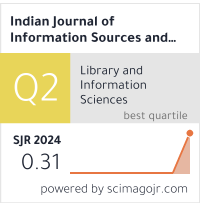A Proficient Obtrusion Recognition Clustered Mechanism for Malicious Sensor Nodes in a Mobile Wireless Sensor Network
DOI:
https://doi.org/10.51983/ijiss-2023.13.2.3793Keywords:
Information Classification, Malicious Node, Irregular Set, Route Entry TableAbstract
A collection of wireless nodes that may be installed at any location and at any time without requiring an established network structure is called a mobile wireless sensor network. The problem of network performance arises from the mobility of nodes and their misbehaviour. Network performance is negatively impacted by data loss and sensor node misbehaviour. In certain cases, there are malicious sensor nodes that are designed to destroy the network’s capacity. This work aims to identify hostile nodes using an irregular set technique. The route entry table’s broadcasting metadata helps identify rogue nodes. Every sensor node in the network broadcasts information about adjacent nodes and maintains a sentry table. Premeditated data delivery proportion, throughput, delay, packet drop, and fault rate are used to estimate broadcasting record parameters. In the NS2 environment, mobile nodes with varying velocities are simulated. To generate an information table, mobile nodes with varying speeds are examined based on their broadcasting records. On the basis of guidelines taken from the irregular set tactic table, good and bad nodes are distinguished. Packets are disseminated along the shortest path that doesn’t contain any malicious nodes. The results of the proposed technique show that an irregular set tactic increases throughput, network capability, data delivery percentage, and end-to-end delay reduction in mobile sensors.
References
Warrier, M. M., & Kumar, A. (2016). An Energy Efficient Approach for Routing in Wireless Sensor Networks. Procedia Technology, 25, 520-527.
Shahraki, A., Taherkordi, A., Haugen, Ø., & Eliassen, F. (2020). Clustering objectives in wireless sensor networks: A survey and research direction analysis. Computer Networks, 180.
Priyadarshi, R., Gupta, B., & Anurag, A. (2020). Deployment techniques in wireless sensor networks: a survey, classification, challenges, and future research issues. The Journal of Supercomputing, 76, 7333-7373.
Rajesh, D., & Jaya, T. (2022). Energy competent cluster-based secured CH routing EC2SR protocol for mobile wireless sensor network. Concurrency and Computation: Practice and Experience, 34(1), e6525. DOI: 10.1002/cpe.6525.
Singh, G., et al. (2015). Classification of Wireless Sensor Networks Clustering Techniques. International Journal of Applied Engineering Research, 10(10), 24747-24757.
Gholami, M., Taboun, M. S., & Brennan, R. W. (2019). An ad hoc distributed systems approach for industrial wireless sensor network management. Journal of Industrial Information Integration, 15, 239-246.
Prabhu, Boselin. (2015). Distributed Clustering Using Enhanced Hierarchical Methodology for Dense WSN Fields. International Journal of Applied Engineering Research, 10(6).
Serhani, A., Naja, N., & Jamali, A. (2020). AQ-Routing: mobility, stability-aware adaptive routing protocol for data routing in MANET-IoT systems. Cluster Computing, 23, 13-27.
Alharbi, M. A., Kolberg, M., & Zeeshan, M. (2021). Towards improved clustering and routing protocol for wireless sensor networks. EURASIP Journal on Wireless Communications and Networking, 2021(46).
Wahid, A., & Kumar, P. (2015). A survey on attacks, challenges and security mechanisms in wireless sensor network. International Journal for Innovative Research in Science and Technology, 1(8), 189-196.
Al-Sulaifanie, A. I., Biswas, S., & Al-Sulaifanie, B. K. (2017). AH-MAC: Adaptive Hierarchical MAC Protocol for Low-Rate Wireless Sensor Network Applications. Journal of Sensors, 2017, 1-15. DOI: https://doi.org/10.1155/2017/8105954.
Singh, S. P., & Sharma, S. C. (2015). A Survey on Cluster Based Routing Protocols in Wireless Sensor Networks. Procedia Computer Science, 45, 687-695.
Pundir, S., Wazid M., Bakshi A., & Singh D. P. (2021). Optimized Low-Energy Adaptive Clustering Hierarchy in Wireless Sensor Network. In: Deshpande P., Abraham A., Iyer B., Ma K. (eds) Next Generation Information Processing System. Advances in Intelligent Systems and Computing, 1162.
Jasim, A. A., et al. (2021). Energy-Efficient Wireless Sensor Network with an Unequal Clustering Protocol Based on a Balanced Energy Method (EEUCB). Sensors, 21(3), 784.
Khan, M. K., et al. (2021). Hierarchical Routing Protocols for Wireless Sensor Networks: Functional and Performance Analysis. Journal of Sensors, 2021.
Alrashidi, M., et al. (2020). Energy-Efficiency Clustering and Data Collection for Wireless Sensor Networks in Industry 4.0. Journal of Ambient Intelligence and Humanized Computing.
Faria, P. H., Costa, J. F. C. L., & Bassani, M. A. A. (2021). Multivariate geostatistical simulation with PPMT: an application for uncertainty measurement. Applied Earth Science.
Pal, R., Yadav, S., Karnwal, R., et al. (2020). EEWC: energy-efficient weighted clustering method based on genetic algorithm for HWSNs. Complex & Intelligent Systems, 6, 391-400.
Gantassi R., Gouissem B. B., Othmen J. B. (2020). Routing Protocol LEACH-K Using K-Means Algorithm in Wireless Sensor Network. In: Barolli L., Amato F., Moscato F., Enokido T., Takizawa M. Web, Artificial Intelligence and Network Applications. WAINA 2020. Advances in Intelligent Systems and Computing, 1150.
Cao, B., Deng, S., Qin, H., et al. (2021). A novel method of mobility-based clustering protocol in software defined sensor network. EURASIP Journal on Wireless Communications and Networking, 2021, 99.
Dhananjayan, G., & Subbiah, J. (2016). T2AR: trust-aware ad-hoc routing protocol for MANET. Springer Plus, 5, 995.
Jain, M., & Bhatnagar, M. (2014). A Rough Set based Approach to Classify Node Behavior in Mobile Adhoc Networks. Journal of Mathematics and Computer Science, 11, 64-78.
Chauhan, A., & D., S. (2015). Detection of Packet Dropping Nodes in MANET using DSR Protocol. International Journal of Computer Applications, 123(7), 0975-8887.
Mehmood, A., Khanan, A., Mohamed, A. H. H. M., & Song, H. (2018). ANTSC: An intelligent Naïve Bayesian probabilistic estimation practice for traffic flow to form stable clustering in VANET. IEEE Access, 6, 4452-4461.
Khan, Z. A., & Herrmann, P. (2019). Recent Advancements in Intrusion Detection Systems for the Internet of Things. Security and Communication Networks, 2019.
Hu, Z. Z., Leng, S., Lin, J. R., et al. (2021). Knowledge Extraction and Discovery Based on BIM: A Critical Review and Future Directions. Archives of Computational Methods in Engineering.
Umar, M. M., Mehmood, A., & Song, H. (2016). SeCRoP: Secure CH centered multi-hop routing protocol for mobile ad hoc networks. Security and Communication Networks, 9(16), 3378-3387.
Muthusenthil, B., Kim, H., & Surya Prasath, V. B. (2020). Location Verification Technique for Cluster Based Geographical Routing in MANET. Informatica, 31(1), 113-130.
Zhang, W., Han, D., Li, K. C., et al. (2020). Wireless sensor network intrusion detection system based on MK-ELM. Soft Computing, 24, 12361-12374.
Rajesh, D., & Rajanna, G. S. (2022). CSCRT protocol with energy efficient secured CH clustering for smart dust network using quantum key distribution. International Journal of Safety and Security Engineering, 12(4), 441-448. DOI: https://doi.org/10.18280/ijsse.120404.
Shanmugam, R., & Kaliaperumal, B. (2021). An energy-efficient clustering and cross-layer-based opportunistic routing protocol (CORP) for wireless sensor network. International Journal of Communication Systems, 34(14).
Downloads
Published
How to Cite
Issue
Section
License
Copyright (c) 2023 The Research Publication

This work is licensed under a Creative Commons Attribution-NonCommercial-NoDerivatives 4.0 International License.









